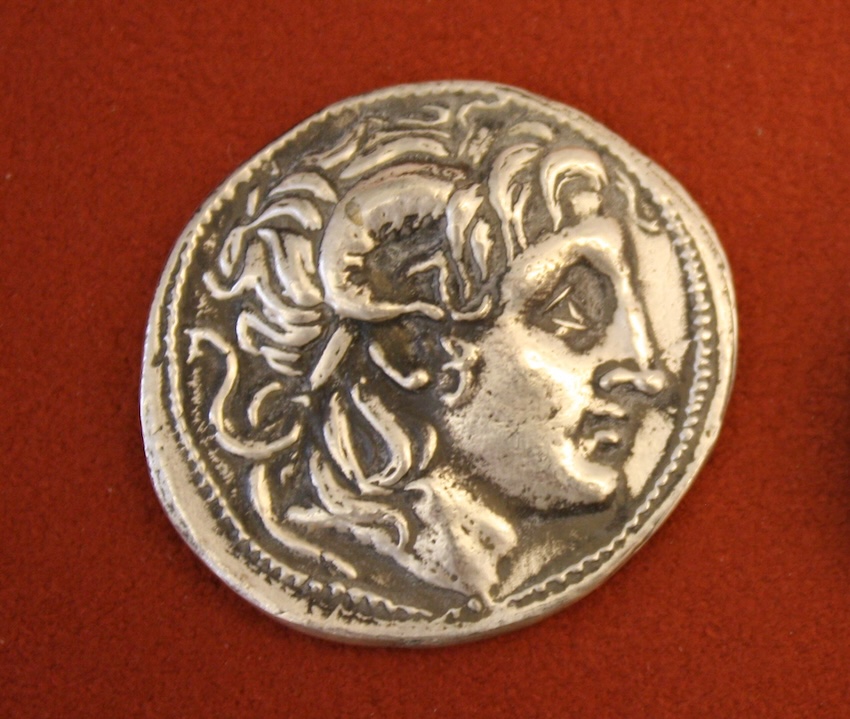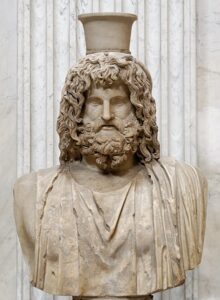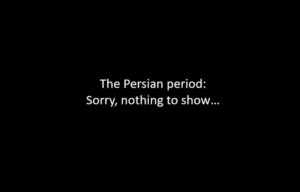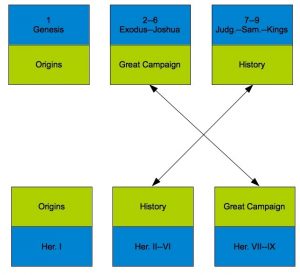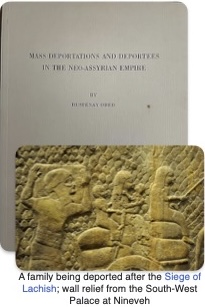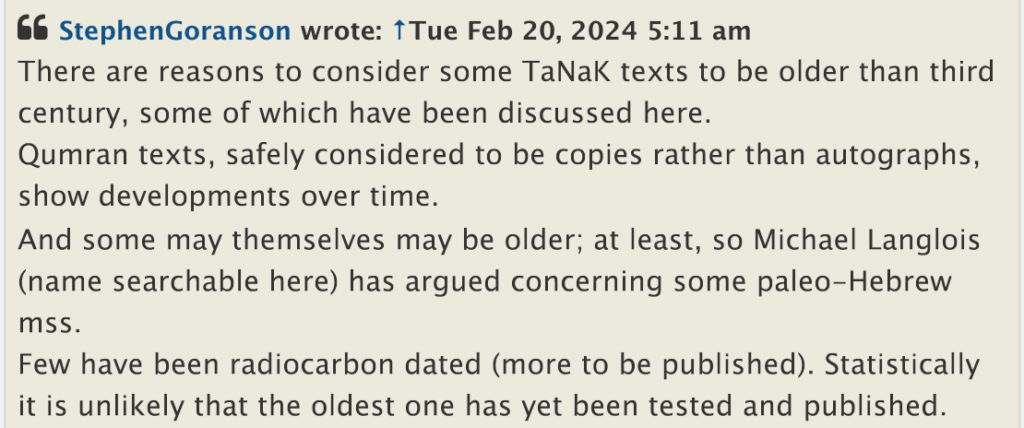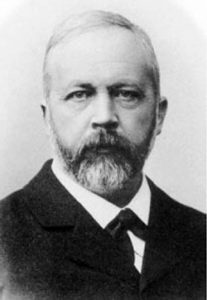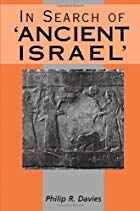Continuing from Why Josiah’s Reforms “Must Have Happened” – part 1
Rainer Albertz is disputing the arguments of Philip R. Davies that the book of Deuteronomy could not have been written as early as the time of King Josiah.
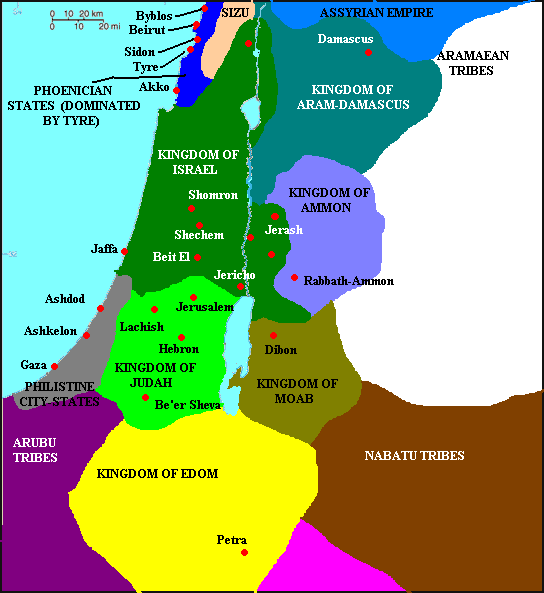
Argument 1:
According to Davies, since Deuteronomy uses the name “Israel” to refer to all of the people of the kingdoms of Israel and Judah, it would not have made sense in the time of Josiah. The reason? In the time of Josiah “Israel” referred only to the northern kingdom, not to Josiah’s kingdom of Judah in the south. See the map. Furthermore, the northern kingdom of Israel had already been overcome by the Assyrians so it no longer existed in Josiah’s time. Deuteronomy’s Israel is a fully united people of all twelve tribes, Judah included — an anomaly in the seventh century BCE.
Albertz’s rebuttal is as follows:
1. — The name “Israel” in the books of Samuel and Kings can sometimes refer exclusively to the northern kingdom of Israel but it can also refer more generally to the kingdoms of Israel plus Judah — 2 Samuel 5:12; 6:20-21; 8:15; 19:22; I Kings 1:34; 4:1; 11:42.
2. — Isaiah 8:17 “clearly contradicts Davies’ hypothesis”:
[I]n Isa. 8.17 the prophet Isaiah could call the Southern and Northern Kingdom ‘both houses of Israel’. Here the term ‘Israel’ explicitly embraces the two states ( בתים ). This means that unless one wants to question Isaiah’s preaching during the Syro-Ephraimite crisis 734-732 BCE, the inclusive meaning of the name ‘Israel’ is already common during the eighth century. (31)
3. — The Book of Nehemiah,
which we can date with a high degree of probability in the second part of the fifth century, does not lay any emphasis on the term ‘Israel’. . . . Thus it seems to me extremely difficult to explain the inclusive usage of the term ‘Israel’ in Deuteronomy from a fifth century background.” (31f)
4. — The biblical record speaks of the two kingdoms, north and south, sharing “common moral and religious values.”
‘No such thing ought to be done in Israel’, said the Judaean princess Tamar to Amnon who wanted to rape her in Jerusalem. The God Yhwh is always named the ‘God of Israel’, never the God of Judah, even when he was venerated in Jerusalem. (32)
Argument 2:
Another reason Davies cannot accept Deuteronomy being a product of seventh century Judah is the book’s call to destroy the religious icons of the “nations” of the land, even to wipe out those peoples themselves. Such a call in seventh century Judah, a kingdom that consisted of a number of population groups and most likely different religious customs, would have been a call to civil war against a huge swathe of the king’s population. Much more likely, in Davies’ view, is that Deuteronomy was addressing an ideological conflict between immigrants and the indigenous population.
Albertz’s response:
Philip Davies thinks that the sharp distinction between Israel and the foreign nations presented by the Deuteronomy would make no sense in a reform under a king whose subjects include a plurality of cultures or population elements . . . . Interpreted as a contrast between the immigrants and the indigenous population it would fit much better in the conflict between the returnees and the ‘people of the land’ in the Persian period. It can be admitted that there are material parallels between the concepts of Deuteronomy and Ezra/Nehemiah. Nevertheless, there is the problem that the terminology in Deuteronomy and in Ezra/Nehemiah is completely different . . . .
Albertz notes the different terminology used by Deuternomy and Ezra/Nehemiah for “foreigners” and “people of the land” and “nations in the land”. Ezra/Nehemiah, of course, is in Albertz’s view most probably from the Persian era when Judeans were returning in Persian times to their homeland from their Babylonian exile.
Thus it is not possible to bring Deuteronomy and Ezra-Nehemiah into a literary coherence. (33)
For Albertz, the differences in terminology and character of the two works — Deuteronomy and Ezra/Nehemiah — testify to the unlikelihood of them both coming from the same time in the relatively small population province of Persian Yehud. The works are too different for us to imagine them coming from the same place and time, especially given the small size of that place at that time.
Further, we must accept that when Ezra/Nehemiah speaks of a reading of the Law, it is referring to the reading of Deuteronomy (Neh 13:1-2; Deut 23:4). Hence Deuteronomy must have existed “a long time” prior to Ezra/Nehemiah (33).
Besides, Albertz continues, in the time of Josiah the multiple population groups within the kingdom of Judah would have merged more or less into a single cultural entity, so Josiah’s call for religious reform would have been aimed at the remnants of idolatry that had crept in when the Assyrians had dominated the area. The Assyrians had by Josiah’s time since left, leaving Judah a newly found independence, Albertz suggests.
Argument 3:
Philip Davies followed S.A. Geller (2000: 273-319) who stated that Deuteronomic legislators support an individual concept of covenant that would constitute a close parallel to the book of Nehemiah. Geller thinks that a new examination of Deuteronomy would conclude ‘that the collectivity of the covenant community barely masks the fact that it is a radically new type of association of individuals’ (2000: 300). Geller and Davies have rightly pointed out that many laws of Deuteronomy stress the responsibility of the individual, like Deut. 13.7-12. (33)
That is, Deuteronomy and the “evidently” Persian era Nehemiah share the same concept of a covenant between the individual and God as distinct from the supposedly pre-Persian notion of a collective national covenant.
Albertz replies:
Yes, Deuteronomy does contain the idea of an individual responsibility but this does not negate the notion of collective responsibility. Thus, for instance,
the rule of Deut. 24.16 that a son should not be punished for the sins of his father and vice versa is only valid for human jurisdiction. If God’s jurisdiction is involved, then Deuteronomic legislators know a collective responsibility for appeasing God’s anger (e.g. Deut. 21.1-9). And the same is valid for the Deuteronomic concept of covenant: in all passages where it is unfolded in some detail (Deut. 26.16-19; 28.69-29.28) it is always a collective ‘you’ who enters into the covenant with YHWH. (33f)
Deuteronomy, Albertz reminds us, has often been thought to have been influenced by the Assyrian vassal treaties that hold a king and his subjects collectively bound in loyalty to the Assyrian king.
אמנה = covenant. See https://biblehub.com/hebrew/1285.htm
ברית = agreement. See https://biblehub.com/hebrew/548.htm
Note 25: See STEYMANS, Hans U.. Deuteronomy 28 and Tell Tayinat.
This collective shape of the Deuteronomic concept is a heritage of the Assyrian vassal-treaties, which gave the model. A closer comparison between the shapes of covenant in Deuteronomy and Ezra/Nehemiah reveals a decisive difference: what had been a collective covenant in accordance with the vassal-treaties in Deuteronomy became in Ezra 10 and Nehemiah 10 an individual commitment according to private contracts; no longer God but only the community made the agreement, and all leaders of the families of the different groups of society signed personally that they were going to commit themselves to specific moral and religious duties. Not by chance does a different terminology for such a self commitment ( אמנה instead of ברית ) occur in Neh. 10.1. These differences in the covenant concepts are so fundamental that it is unlikely that both could come from the same post-exilic period. In my view, the parallels between the Deuteronomic concept of covenant and the Assyrian vassal-treaties make a dating in the seventh or at latest in the sixth century more probable.25
Argument 4:
Then there is the law in Deuteronomy that neuters the king of all his privileges and traditional powers.
Davies mainly pointed out that the radical limitations of monarchical power made in 17.16-20 were completely unrealistic: ‘There are no plausible explanations why a king should accept a reform that deprives him of the essential powers of monarchy, justice and warfare’ . . . (34)
Albertz:
Admittedly, the law of kings sounds unrealistic to us; the question remains whether a later date would make its utopian concept more realistic. Moreover, there is no hint in the text that its author was looking forward to the restoration of an idealized kingship (cf. Nelson 2002: 223), in contrast to many exilic and postexilic prophetic texts. Every attempt to date Deut. 17.14-20 in the Persian period is confronted with the problem that this law still held on to the divine election of the king according to the Davidic theology (Ps. 89.4,20), whereas the Davidides disappeared from the political stage after the failure of Zerubbabel 519/518 BCE. (34)
29. Cf. Rüterswörden 1987: 102-105, who pointed out that the deprivation of the king’s power as seen in Deut. 17 has some similarities in the Greek history of polity.
30. The strange prohibition of bringing back the people to Egypt in order to multiply horses motivated by an oracle of YHWH (Deut. 17.16aβb), which seems to be inserted into its context, can easily have reference to the military alliance between Zedekiah and Psammetichus II in the years between 594 and 591 BCE. That alliance probably included the supply of Judaean mercenaries for Egypt, cf. Albertz 2002: 27. If this reference is accepted, we would have a terminus ad quem for the Deuteronomic law of kings.
Albertz appeals further:
What the Deuteronomic legislators intended with their radical law was nothing else than the creation of what was called later a ‘constitutional monarchy’. The measures may have been impractical to some degree and somewhat utopian like other archaic reform models of the ancient world,29 but the goal was very concrete and — as we can see in the later history of humankind — with other measures definitely realizable. But why should such a far reaching constitutional reform be conceptualized at a time when the legal limitation of monarchic power was completely irrelevant for Judah? In my view, the most probable period for dating the Deuteronomic law of kings are the reigns of Jehoiakim and Zedekiah, when the alliances with Egypt became a new threat for Judah (17.16) and when the Shaphanide scribes, who are the best candidates for having written the Deuteronomic law, resisted the ruling kings (Jer. 26.24; 36.9-26).30 (35)
Argument 5:
Philip Davies suggested that the centralization of the cult was a problem of the early Persian period, when after the reconstruction of the Jerusalem temple its claim to be the only authorized temple of YHWH had to be carried through against the claim of other cult places like that in the former capital Mizpeh. (36)
Here is Davies’ argument. Yes, the prophetic books of Isaiah and Ezekiel do presuppose a centralized cult at Jerusalem, but
. . . the realities of life in Judah during the neo-Babylonian period [inform us that] the capital was at Mizpeh. We do not know whether Jerusalem had any kind of sanctuary at this time, but evidence does suggest that several sanctuaries in the vicinity of Mizpah functioned: Gibeon, Mizpah itself, and especially Bethel. How, and when, Jerusalem was reinstated as capital is not clear; the process of building the Persian period temple is itself unclear, and it is unthinkable that the change of capital from Mizpeh to Jerusalem was achieved without some resentment, nor the reinstatement of Jerusalem as the central sanctuary. Indeed, the replacement of Bethel by Jerusalem as the chief sanctuary of Judah in the mid-fifth century explains a great deal about the Josiah tradition, as I shall now suggest. (Davies, 75 in Grabbe, Good Kings and Bad Kings)
Albertz finds Davies’ argument entirely speculative. There is no evidence for the existence of rival temples in Gibeon, Mizpah or Bethel. No other biblical texts indicate that there were rival sanctuaries to YHWH worship in particular.
Thus, we cannot rule out that there were again rivalries between different YHWH sanctuaries in the post-exilic time, but we can say that cult centralization was no serious problem of that period. (36)
Conclusion
On the basis of the above rebuttals to Davies’ arguments for positing that the date of Deuteronomy better fits the Persian era than it does the time of King Josiah, Albertz writes:
Thus we can conclude: None of Davies’ arguments that Deuteronomy 12-26 should be better dated into the fifth century is convincing. There might be some doubts on a seventh century dating, but the Deuteronomic legislation fits rather less well the socio-political conditions and the literature of the Persian period. (36)
As for my own view, I find some of Albertz’s criticisms limited in their focus. His criticism in Argument 1 relies on dating Ezra/Nehemiah to the Persian period and on the assumption that those works reflect genuine history. See for an alternative view my series of five posts on fallacies of historical method and literary criticism that lie at the heart of common interpretations of Nehemiah. Albertz also relies on a face value acceptance that the early chapters of Isaiah were written in the monarchic period.
His Arguments 2 and 3 responses hang entirely upon the assumption that works with quite different terminologies and depictions of local scenarios must be from different periods. But different literary schools from the one region are not so implausible if we stretch our view to the Hellenistic period, a time of increasing population and cultural and social developments.
Argument 4 is evidently one that Albertz himself admits to having some difficulty. He acknowledges that Deuteronomy’s law for the king is “unrealistic to us”. The footnote #29 reminds us of another discussion that does place Deuteronomy’s law in a Hellenistic setting:
Pentateuchal legislation did, however, envision a day when the children of Israel would ask for a king, and the Torah of the King (Deut. 17.14-20) specified the qualifications required of that office. The description of the office of king contains many problematic elements inconsistent with the biblical monarchy in Samuel-Kings or indeed with kingship as practiced in the Ancient Near East. The king of the Ancient Near East was a ruler over subjects, with authority passed down within a dynastic royal line, and whose dominion was an expression of raw power. Ancient Near Eastern kings exercised supreme military, judicial, economic, executive and (as patrons of temples) cultic powers. Although these features of Ancient Near Eastern kingship generally cohere with the picture of kingship in Samuel-Kings, they do not correspond to implicit and explicit features of kingship in Deuteronomy. For instance, the Deuteronomic king appears to have been appointed by his fellow-citizens, that is, by the citizen assembly; the king’s rule was to be subject to written laws, from a copy prepared under priestly supervision; the king was assigned no military, judicial, cultic or executive responsibilities, and indeed the duties of his office are entirely unclear in the Torah of the King. Although the title is that of king, in actuality the envisioned office of kingship appears to resemble that of other Ancient Near Eastern kings in name only. Nor did the Deuteronomic kingship resemble the Judean monarchy of biblical historiography. The commands against accumulating horses, wealth and wives – especially foreign wives – were a conscious contrast to king Solomon’s reign. The famous speech of Samuel against the kingship at 1 Sam. 8.11-18 also implicitly contrasted the Deuteronomic ideal with the actual monarchy of Judah, which Samuel pictured as quickly descending into a tyranny in which the creation of a standing professional army (8.11-12) and the indulgences of oligarchic luxury of a ruling class (8.13-17) were predicted to result in oppressive taxation and the creation of a poverty-stricken underclass (8.15-18). It is thus difficult to understand the office of king in Deut. 17 as describing any biblical Judean or Israelite king or even as broadly compatible with the institution of kingship as known in the Ancient Near East.
Rather, the office of king as described in the Torah of the King appears to have been conceived along democratic Greek lines. Kingship, when it existed among the Greeks, was often an elected position. Dynastic royal lines were mainly a feature of the legendary past (Aristotle, Politics 3.1285a), with a few exceptions in the historical period, such as at Sparta and Cyrene. The evidence that Athens was ever ruled by a true king is inconclusive. In those city-states that possessed an office of king, the idea of kingship varied from polis to polis. At Sparta there were two kings from different royal houses who presided over the gerousia, and whose equal power provided a check against each other. By Spartan law, their kings functioned as generals and religious leaders only (Aristotle, Politics 3.1285b). At Cyrene, a reform of the kingship deprived the royal line of Battus of most powers, including military command, leaving them with only the priesthood (Herodotus, Histories 4.161; cf. Hagedom 2004: 152; Berman 2008: 190 n. 23). At Mytilene and at Chios there was a panel of kings. At Athens there was a single elected king, the Archon Basileus (described earlier) whose duties, other than supervision of homicide cases, belonged mainly in the ceremonial and religious realm. The Athenian offices of king and military commander (Polemarch) were distinct since at least the Archaic Era (seventh century BCE) . According to Aristotle, the most stable monarchic governments were those in which the functions of the king were most limited. The absence of military duties for the office of king in Deut. 17 is highly reminiscent of elected kingship as practiced in Athens (Hagedorn 2004: 152; Berman 2008: 190 n. 23).
A striking feature of kingship as described in the Torah of the King was its subordination to written law. The book of the law was entrusted to the levitical priests (Deut. 17.18). The king was directed to make a copy of this law under priestly supervision (Deut. 17.18), to refer to it constantly and obey its every precept, in order that his tenure as king be long and happy (Deut. 17.19-20). The requirement that the duties of the king should be performed in strict conformity to written law is a characteristically Greek notion. The creation of a copy of the law for royal reference is strikingly reminiscent of the publication of Athenian laws at the Royal Stoa. The subordination of royal rule to either written law or priestly supervision, as in the Torah of the King, ran contrary to Ancient Near Eastern notions of kingship, but had at least three parallels in early Hellenistic literature. In the Aegyptiaca by Hecataeus of Abdera, it was claimed that the ancient pharaohs of Egypt were directed in their royal activities by priests who ensured their obedience to the strictures of Egyptian law (Diodorus Siculus, Library 1.70-71). In the same text, it was claimed that Darius the Persian not only made a copy of all the ancient laws of Egypt, but studied Egyptian laws with the priests (Diodorus Siculus, Library 1.95.4-5). Finally, in the foundation story of the Jews also written by Hecataeus of Abdera, it was claimed that Moses selected the most capable men of the nation, appointed them as priests and judges, “and entrusted to them the guardianship of the laws and customs” (Diodorus Siculus, Library 40.3.4-5). None of these three Hecataean traditions can be credited as ancient or factual, but instead reflected Greek political notions foreign to both Egyptians and Jews of pre-Hellenistic times. In all three, the priests functioned as nomophylakes or Guardians of the Laws, and in the first two they additionally acted as supervisors and legal advisors to the kings of Egypt. The office of nomophylakes was found in many Greek city-states, including Athens (Aristotle, Athenian Constitution 4.4; 8.4; cf. Stanton 1990: 30-3, 68-73). Their primary responsibility was to ensure the magistrates obeyed the written laws of the polis. Secondarily, the nomophylakes supervised public behavior, ensuring that those violating public decorum were reported to the proper authorities for prosecution. In the Torah of the King, the requirement that the king, as an elected magistrate, should become knowledgeable in the written laws and perform his office in strict accordance with those laws (Deut. 17.18-20) was unequivocally a reflection of Greek political notions. The explicit role of the levitical priests as guardians and public advocates of the written laws that were to be obeyed by the magistrates and people alike, and implicit responsibility for educating the king in his duties of office via these writings and enforcing the written statutes upon the king, casts the levitical priests in the distinctively Greek office of nomophylakes, the same office given the priestly successors to Moses in the Jewish foundation story by Hecataeus. (Gmirkin, 34ff)
Continuing in part 3


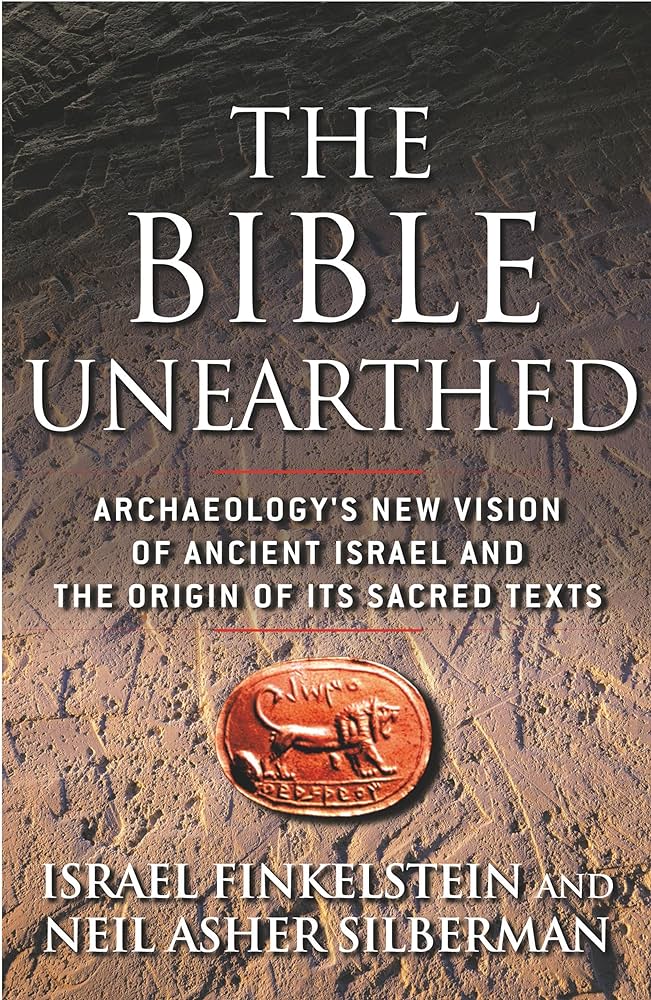

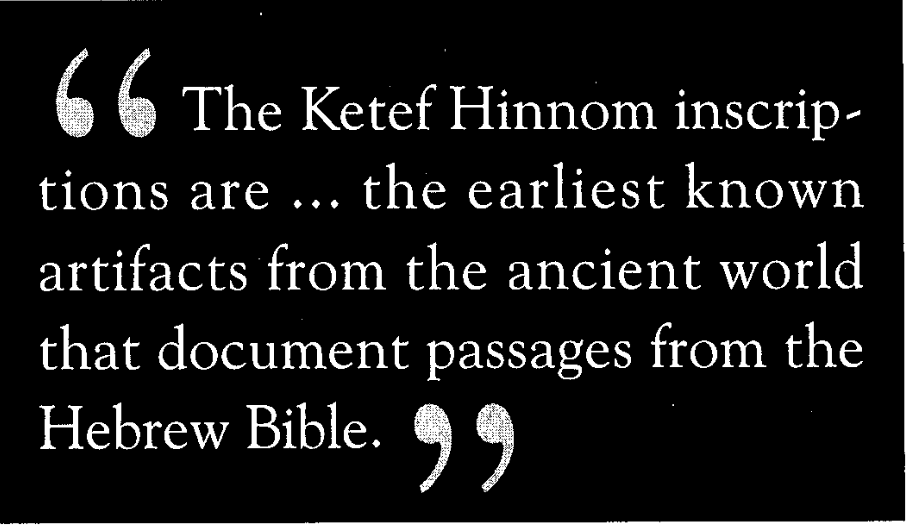
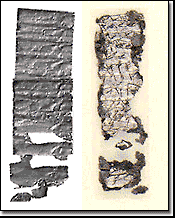
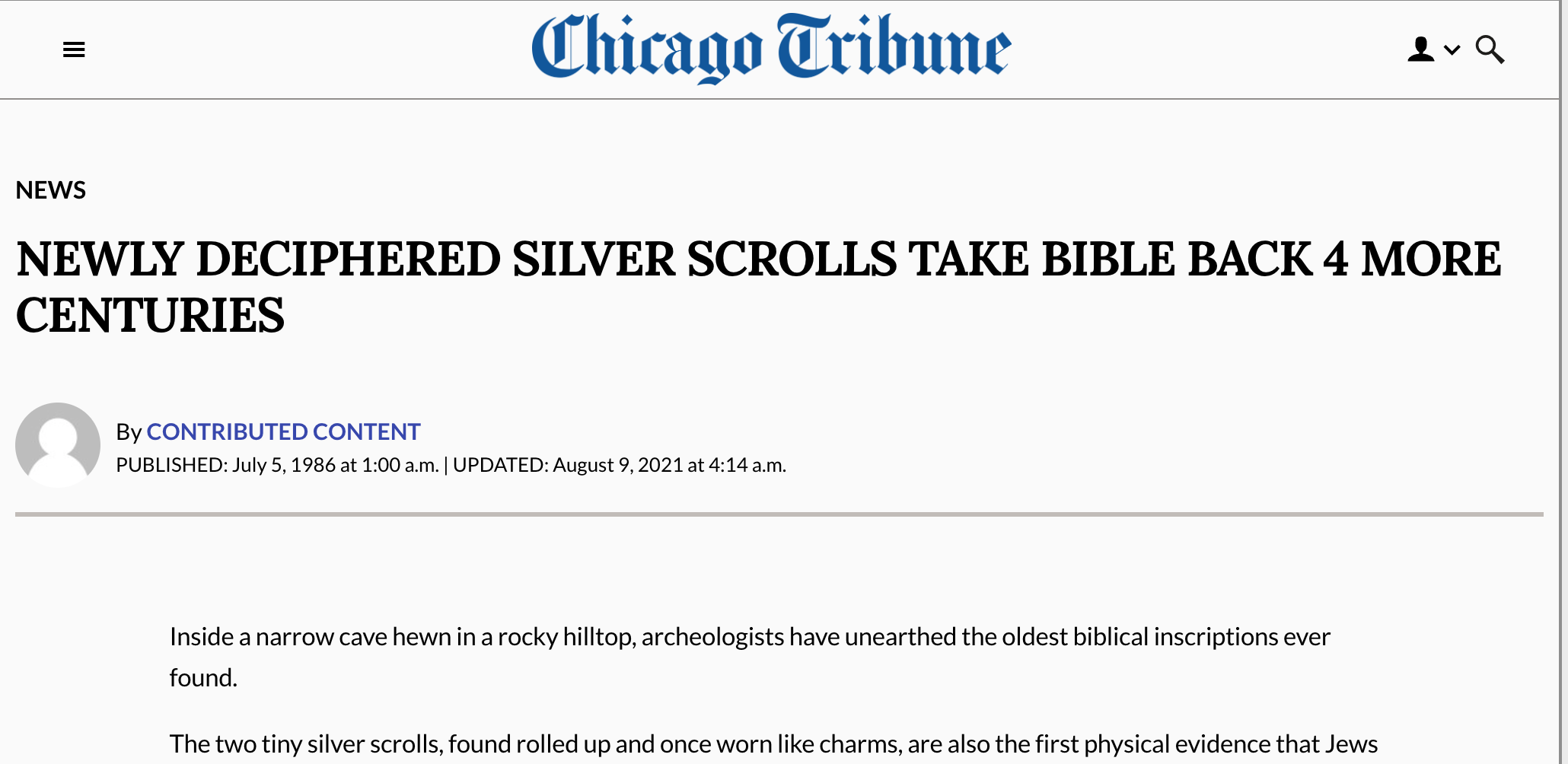

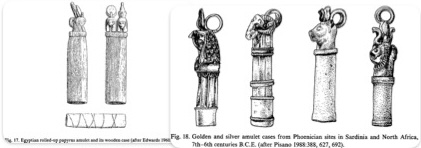


 My reply:
My reply: